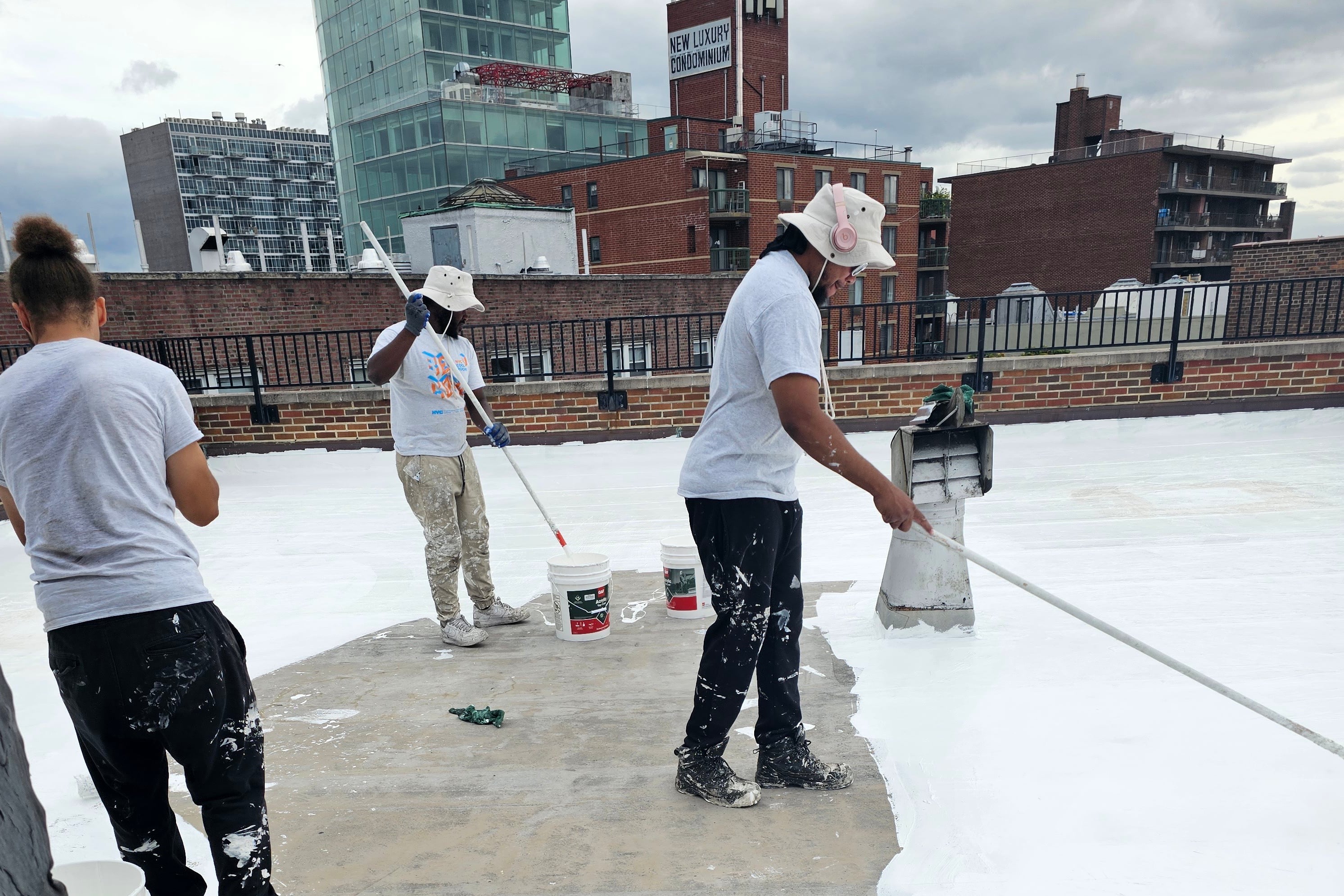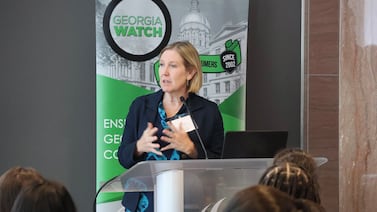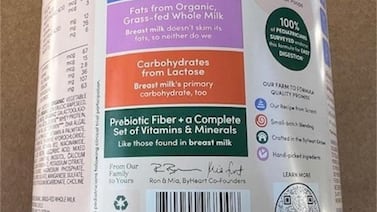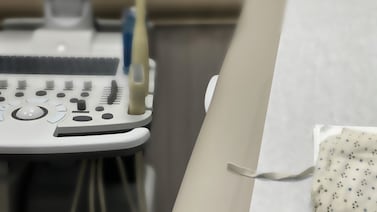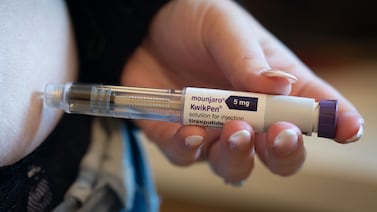Public health, explained: Sign up to receive Healthbeat’s free New York City newsletter here.
Mehdi Heris, a professor at CUNY’s Hunter College, has dedicated his research to bridging the gaps between science and urban planning. As New York City enters another scorching summer, he wants more people to know about a way to lower indoor temperatures by up to 5.9°F: “cool roofs.”
The practice, which involves covering rooftops in a light-reflective coating, had been implemented on at least 36% of the city’s roofs, according to Heris’ research. He has been tracking the efforts of NYC CoolRoofs and The HOPE Program, a job training non-profit focused on sustainability, to cool more of the city’s 1.6 billion square feet of rooftops.
“It is basically low-hanging fruit for communities to start with cool roofs for heat mitigation,” Heris said, citing the free or low-cost program that would allow many buildings to do it. “This is something that can benefit you. This is something that will benefit your energy bill and your health and livelihood.”
Extreme heat is a public health challenge as one of the deadliest effects of climate change, with an estimated 580 New Yorkers dying prematurely last year related to hot weather, according to the 2024 NYC Heat-Related Mortality Report. Last summer, the city saw over 20 days with temperatures over 90°F, a number that is projected to triple by the 2050s, according to the New York City Panel on Climate Change.
Last month, the city launched a dashboard to help New Yorkers and city officials assess heat risks and guide the local response to heat waves.
Heris says reflective roofs are a fast, easy, and cheap (or even free) way to cool buildings. Studies show that in non-air-conditioned residential buildings, the coated roofs can lower maximum indoor temperatures by 2.2 to 5.9°F.
How reflective coating mitigates urban heat island effect
A cool roof is able to lower building temperatures due to its ability to reflect sunlight. It can be installed by either painting on a reflective coating, installing a reflective membrane, or installing cool shingles. Cool shingles are made of either asphalt, wood or polymer, and work best on pitched roofs.
The NYC CoolRoofs program only offers to paint reflective coating on flat roofs. Coating dark roofs requires maintenance over time due to wear from weather. But installing a cool roof in the first place will help it last.
The reflective coating helps combat the urban heat island effect, where air temperature is hotter in cities than surrounding suburban and rural areas.
“The things that we have constructed our cities out of often absorb and retain and then re-radiate more heat … things like asphalt building roofs, or particularly, dark, tar-based building roofs,” said Travis Flohr, assistant professor of landscape architecture at Penn State and co-researcher with Heris of “Cool Roofs in a Warm City.”
With dark roofs, heat is absorbed by the building, said Mike Treglia, lead scientist for the New York Cities Program at The Nature Conservancy.
“One of the biggest issues of the urban heat island effect is that cities don’t really cool down as much at night as other areas,” Treglia said. “It’s not just the daytime heat stress that people face, but also not being able to cool down in their un-air-conditioned apartments at night.”
This is even more difficult for people with underlying conditions such as asthma, heart disease, and diabetes, according to the World Health Organization. People who have chronic health issues are more vulnerable to heat because they retain more body heat or due to medications they take.
The city has a program to help New Yorkers buy and install an air conditioner. But about 21%, or 493,000 rental households across the city, don’t run their AC because of the cost, a 2023 housing and vacancy survey found.
A cool roof can lower energy bills. According to the study by Heris and Flohr, installing a cool roof can cut cooling costs by 7%-15%. This also lowers carbon emissions and helps the city reach its goal of carbon neutrality by 2050. Every 2,500 square feet of roof that is coated can reduce the city’s carbon footprint by 1 ton of CO2.
To reach this goal, the city passed Local Law 97 to lower greenhouse gas emissions from buildings, the source of two-thirds of the emissions in the city, according to NYC Buildings. Buildings originally were required to send in data on their emissions starting at the end of this month, but the department recently gave property owners more time to comply.
NYC program offers free roof coating for many buildings
The NYC CoolRoofs program, which is run in partnership with the city’s Department of Small Business Services, the Mayor’s Office of Climate and Environmental Justice, and The HOPE Program, has covered over 12 million square feet of roofs since 2009 with reflective coating.
The HOPE Program is hoping to partner with non-profit organizations around the five boroughs to get more buildings to install cool roofs – especially in neighborhoods that have a higher heat vulnerability, like the South Bronx and parts of Brooklyn. These boroughs are more vulnerable to the heat due to the lack of trees and other green space that provide shade.
Heris has worked with groups like South Bronx Unite and El Puente in his research. They are “important groups, because they are really connected to their community. If we can provide some knowledge for them that becomes good material, to go to the community and take these numbers and see just this is how it’s gonna happen.”
Thirty percent of flat, dark roofs across the city could have a cool roof installed, Heris said. For eligible buildings, the service is free. To qualify, roofs must be flat, in good condition, accessible to workers, and made of certain materials, like asphalt and bitumen.
The expense of needed repairs is a major barrier for keeping buildings out of the program, especially in disadvantaged areas, said Kendra Jones, director of HOPE’s Bronx programs.
“The repairs that we would need to be on the roof is a higher priority than the actual coating itself,” she said.
HOPE has mostly been working on residential buildings, but is planning more outreach to larger commercial buildings.
“The return is so good, you don’t really need to think about whether [you] should do it or not,” Heris said.
This story was produced in partnership with the Health & Science Reporting Program at the Craig Newmark Graduate School of Journalism at CUNY.

